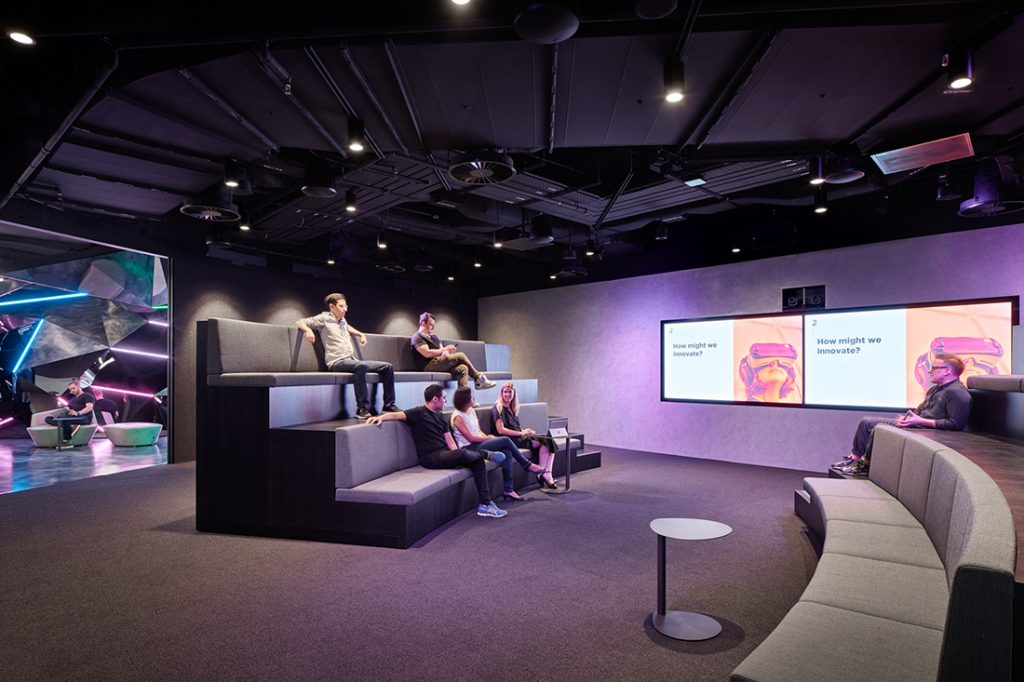The uncomfortable realities of working from home are sinking in, says Penny Sloane from Siren Design, who sees connection as a key driver in bringing people back to the office – flexibly.
The honeymoon is over, says Penny Sloane. Over a year into the pandemic, working from home just doesn’t hold the same appeal – a feeling shared by many organisations and their people.
“Everyone has enjoyed the flexibility of working from home. It’s nice to have that option, but not full-time,” says the Managing Director of the Singapore office for Siren Design, a women-led, sustainability-focused design firm.
“Having that separation between home and work is definitely desirable,” says Sloane. “And it’s all so much easier face to face. If you’re working from home, you’re missing out on learning opportunities, opportunities to grow.” For design firms, remote work also means “you miss out when a partner or a supplier comes to the office to show you something new.”

A variety of furniture settings and ways of working in this office by Siren Design
Moving forward, she thinks most businesses will operate on a hybrid model. Employees will have the option to work remotely for one to two days a week, and time in the office to connect and collaborate. “If you’re coming to the office, you’re coming to meet, whether that’s in a formal or informal way.”
To be clear, Sloane doesn’t think the elements within the office will change all that much. “The kit of parts hasn’t changed; it’s the ratio of the kit that has changed.”
Before the pandemic, many companies would have regarded a sharing ratio – fewer than 1:1 desks per person – as unthinkable. Now, however, Sloane says many clients are seeing the potential.

Multiple connection points, both formal and informal, at the PwC Experience Centre by Siren Design
“There are fewer individual workstations, and there are more different types of furniture settings. There are more of your collaboration spaces, your cafes, vitality areas [where people can come together] and spaces for well-being. Focus areas and detachment zones. All of that has grown.”
Clients are also opting for smaller meeting rooms, says Sloane, “because you have half the team dialing in.”
These meeting rooms will serve another purpose, however. “A meeting room will also be an office, and it’s also a space to go and chill in. You’re not going to see any single-use spaces – you’re not suddenly going to build a yoga studio.”

A multipurpose meeting and presentation space at the PwC Experience Centre by Siren Design
While this may seem to go against physical distancing requirements, clients “are staying flexible for future pandemics for sure,” and they’re using furniture to deliver that flexibility.“Last year we did numerous studies for tech giants on how we can reposition workstations without having extra costs for additional components,” she says. “This way, you’re not churning through different furniture just to meet a certain requirement at a certain point in time.”
And then there’s the psychological aspect of current physical distancing workplace arrangements. “There’s nothing worse than walking into an office and seeing the big cross on a table that says, ‘Don’t’ sit here.’ There’s something really negative about that. If you can simply remove that table top and pop it into a store room really easily, psychologically it feels nicer within the space. It’s going to be really important in the future to have furniture that can do that.”

Reusability and adaptability are going to be vital in the workplace of the future, says Sloane, and it’s become a core part of Siren Design’s ethos, with the whole business recently shifting its focus to a circular one.“You have to be able to reuse everything,” says Sloane. “If you have to replace the whole beam under a workstation, what’s the point? You need to be able to pull it apart to create different clusters.”
This is where Herman Miller’s workplace furniture can make all the difference. Atlas Office Landscape, for example, features a connected leg that can be rotated in order to shift between desk formations – and numbers – with minimal effort, time or extra parts. It’s an approach that’s both sustainable and flexible.


Atlas Office Landscape | Designed by Tim Wallace
Then there’s Public Office Landscape, another Herman Miller office furniture system that caters to connection, collaboration, and of course, flexibility. “You can have a collaboration bench at the end of your workstation, or a table, or soft seating,” says Sloane. “It gives a bit of privacy to what’s happening at the end of the workstation, but also keeps the team connected. It’s an elegant solution. I love all Herman Miller’s pieces that allow you to plug and play like this.”

Public Office Landscape
Beyond furniture and design, however, Sloane argues that flexibility requires user buy-in. The people working in the space need to “think flexibly. They need to see they can use a table as a workstation, a meeting space, or move it somewhere else to create scrum space,’ says Sloane.
Organisations and leaders also need to take this approach. “They need to be thinking, ‘Do we actually need this? What makes us perform better?’”

Public Office Landscape
Sloane believes remote work and the pandemic have already paved the way for this line of thinking. “It’s opened everyone’s eyes about how to be more targeted with the purpose of the office. This is the main driver of the future workplace, which is pretty cool.”
Explore Public Office Landscape here and Atlas Office Landscape here.
This article originally appeared on IndesignLive.sg

